Complete Solutions to CHEMISTRY of chapter TS EAMCET 2019 (6 MAY SHIFT 1) of Class 12 book with complete answers and questions
| Class 12 | CHEMISTRY |
| Chapter | TS EAMCET 2019 (6 MAY SHIFT 1) |
| TS EAMCET | CHEMISTRY |
| Number Of Questions | 40 |
| Academic Year | 2023-24 |
The speed of the electron (in ms^(-1)) in the third orbit of hydrogen atom is approximately (mass of electron `=9.1xx10^(-31)kg`)
View SolutionThe ratio of the radius of second orbit of `Li^(2+)` to that of thired orbit of `Be^(3+)` is
View SolutionAssertion (A) While going from left to right of the periodic table, the atomic size decreases more rapidly for the 3d-series compared to the 4 f-series of elements. Reason R 3d-electrons experience lesser shielding then 4 f-electrons.
The correct answer is
View SolutionWhich one among the following statements is/are not correct?
I. Ba compounds, generally are more covalent than Be compounds.
II. The electron gain enthalpy of He is positive.
The oxidation state of O in `OF_(2)andNa_(2)O` are same.
IV. The radius of `Na^(+)` ion is smallare than that of `F^(-)` ion.
View SolutionWhich of the following have linear structure
I. `SnCl_(2)` II. `BeF_(2)`
III. `SO_(2)` IV `overset(+)NO_(2)`
`C_(2)H_(2)`
View SolutionMatch the following :
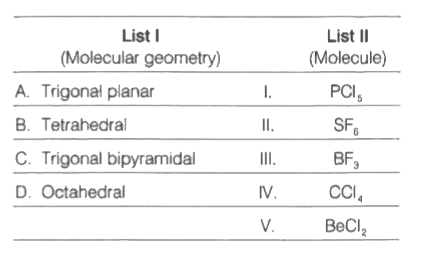
The correct answer is
View SolutionWhich of the following is/are correct for Boyle's law ?

View SolutionThe compressibility factor (Z) of a gas at critical state is
`(T_(e)=(8a)/(27Rb),p_(e)=(a)/(27b^(2)),V_(e)=3b)`
View SolutionThe number of moles of `H_(2)` which is required to produce 10 moles of `NH_(3)` in the following reaction is
`aH_(2)(g)+bNO_(2)(g)tocNH_(3)(g)+dH_(2)O(g)`
View SolutionMatch the following :
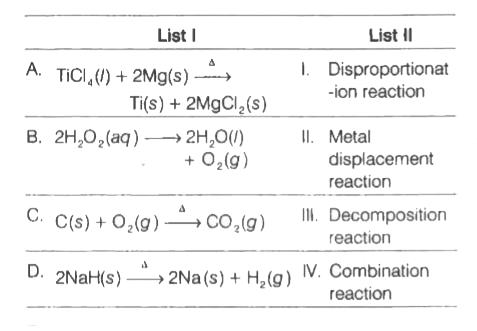
The correct answer is
View SolutionWhat is the standard enthalpy of rection (in kJ) when two moles of `Fe_(2)O_(3)`(s) reacts with `H_(2)` gas to give Fe metal?
`DeltaH_(f)^(@)` of `Fe_(2)O_(3)(s)andH_(2)O(l)` are -824.2 and `-285.83kJmol^(-1)` respectively.
View SolutionIn which of the following plots, an endothermic reaction if correctly represented?
View SolutionWhat is the order of relative basic strength of `ClO_(2)^(-),ClO_(3)^(-),ClO_(4)^(-)?`
View SolutionHow many water molecules present in `CuSO_(4).5H_(2)O` are hydrogen bonded?
View SolutionWhich gas/gases evolve (s) when sodium metal is reacted with at room temperature?
View SolutionA and B are formed when borax, is dissolved in water. C and B are formed when borax is reacted with aqueous HCl solution. What are A and C respectively?
View SolutionHow many nearest neighbours are there for Si and O atoms in quartz crystals?
View SolutionMatch the following :
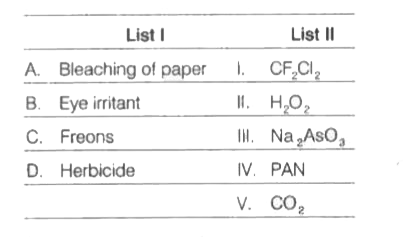
The correct answer is
View SolutionWhich of the following method is adopted to obtain gasoline from crude oil?
View SolutionWhich of the following statements is correct in the Kolbe's electrolysis?
View SolutionThe correct order of rates of C-Br bond ionisation of the following bromides is
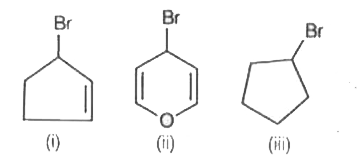
View SolutionIf an element having atomic number 96 crystallises in cubic lattice with a density of `10.3gcm^(-3)` and the edge length of 314 pm then, the structure of solid is
View SolutionThe vapour pressure of pure `C""Cl_(4)` (molar mass `=154gmol^(-1)`) and `SnCl_(4)` (molar mass `=170gmol^(-1)` ) at `25^(@)C` are 115.0 and 238.0 torr respectively. Assuming ideal behaviour, calculate the total approximate vapour pressure in torr of a solution containing 10 g of `C""Cl_(4)` and 15g of `SnCl_(4)`.
View SolutionA camphor sample melts at `176^(@)C.K_(f)` for camphor is 40 K kg `mol^(-1)`. A solution of 0.02 g of a hydrocarbon in 0.8 g of camphor melts at `156.77^(@)C`. The hydrocarbon is made up of 92.3% of carbon. What is the molecular formula of the hydrocarbon?
View SolutionIf 'A' is the reactant and 'P' is the product, which one of the following is the correct form of Nernst equation?
View SolutionThe first order decomposition of `H_(2)O_(2)` in an appropriate medium is characterised by a rate constant of `0.2303min^(-1)`. What is the time (in min) required to complete `9//10` fraction of the reaction?
View SolutionWhich of the following statements is/are not correct?
Adsorption is accompanied by decrease in enthalpy as well as decrease in entropy of the system.
Gases, which can react strongly with adsorbent show chemisorption.
When the value of the slope of the Freundlich isotherm is non-zero, adsorption is independent of pressure.
Gold number of potato starch is 0.15
View SolutionWhich one of the following is used to produce Al by electrolysis?
View SolutionStatement (A) Among the oxides of nitrogen, NO and `NO_(2)` are paramagnetic .
Statement (B) NO is paramagnetic in the gaseous state and diamagnetic in liquid state. The correct answer is
View SolutionThe products formed during the reaction of carbon with conc. `H_(2)SO_(4)` are `C+H_(2)SO_(4)to` products
View SolutionHow many protons will be consumed when dichromate ion oxidises `Fe^(2+)ions` in aqueous acidic medium?
View SolutionWhich one of the following is tris (ethane-1, 2-diammine) cobalt (III) sulphate?
View SolutionWhich of the following polymer is formed due to the co-polymerisation of 1, 3-butadiene and phenylethene?
View SolutionFind the reagent that oxidises glucose into saccharic acid?
View SolutionWhich one among the following is an antioxidant?
View SolutionFind the reactants which on heating with alcoholic KOH produces the compound
`CH_(3)-CH_(2)-CH_(2)-CH=CH_(2)`
View SolutionThe major product (P) formed in the below reaction is
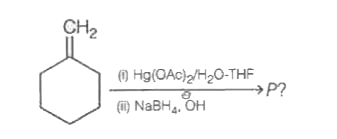
View SolutionIdentify X, Y and Z respectively from the following reactions :

View SolutionIdentify the structure of Z in the following reaction sequence
Phthalic acid `+NH_(3)hArrXoverset(Delta)toYunderset("heating")overset("strong")toZ`
View SolutionThe major products P and Q formed in the following reactions of benzonitrile are

View Solution
CHEMISTRY questions and complete solutions for chapter TS EAMCET 2019 (6 MAY SHIFT 1) of TS EAMCET PREVIOUS YEAR PAPERS of Class 12